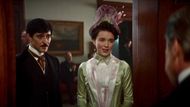The fascinating fraudster of HBO’s The Gilded Age, Maud Beaton, is not an invention of television programming: her persona is based on the life story of one of the most infamous exploits in history. Beaton is based on the story of Cassie Chadwick, a woman who succeeded in defrauding the richest men of New York, bankrupting entire banks and leaving a permanent mark on the business world of the late 19th century.
Those who watched Oscar van Rhijn succumb to the charm of Maud are familiar with the syndrome: she came in with charisma and mysticism, moved among the circles of high society, and left a series of bankruptcies behind her. Her well-constructed image, that of an alleged illegitimate daughter of a tycoon, Jay Gould, was a reflection of the most notorious con of the real Cassie Chadwick, who purported to be the heir to the fortunes of Andrew Carnegie.
The Gilded Age might have given Maud a kind of merciful death; however, the woman that she was based on had to face a far graver destiny.
The Gilded Age: The real-life fraud behind Maud Beaton

Cassie Chadwick (originally Elizabeth “Betty” Bigley) was born in 1857 in Ontario, Canada. Her criminal life started shockingly early when she was thirteen years old, as she faked an inheritance certificate to obtain an advance at her local bank. Cassie was not only arrested but also publicly exposed, but this did not appear to deter her at all, and she continued to plot even more fantastic plans in the course of her adult life.
The famous scam that Cassie committed occurred after a series of lesser cons, marriages, and assumed identities. She impersonated Mrs. Chadwick and persuaded bankers in Cleveland, Ohio, that she was the secret, illegitimate daughter of Andrew Carnegie, who was one of the richest men in the world.
By cashing in on social virtue, as no one would ask Carnegie whether he had an illegitimate child, lest he be embarrassed, Cassie had secured loans of over $2 million, which, today, would amount to approximately $65 million.
She supported her assertions with counterfeit promissory notes, purportedly signed by Carnegie himself, and was able to borrow money on credit supplied by bankers who needed to identify themselves with old money. Her swagger and boldness ensured that even experienced businesspeople were fooled by her tale, and they would not even question her validity in public. There were even those who kept her secrets because they were afraid of being shamed and ruined financially.
Cassie proved incapable of sustaining her network of lies as her debts exceeded her empire, and she was brought down in open court. Andrew Carnegie himself attended her trial and testified that he was not in any way related to Cassie Chadwick and that he had no idea who she was.
The consequences were disastrous: banks collapsed, executives became bankrupt and disgraced, and Cassie herself was condemned to jail, where she died alone, plagued by the havoc she wrought.
Maud Beaton’s arc in The Gilded Age

Using creative liberty, the story of Maud Beaton in HBO’s The Gilded Age relates closely to that of Cassie Chadwick. Maud, portrayed by Nicole Brydon Bloom, enters New York society with a fortune, enigmas, and gossip about a notorious paternity. It supposedly makes her the daughter of Jay Gould, repeating the tactics used by Chadwick to borrow on the reputations of industrial barons and make a personal fortune.
The plot of Maud is especially scandalous in the second season, as she seduces Oscar van Rhijn, a high-profile figure, and lures him into a shady business deal. It is similar to the seduction tricks and premeditated emotional gambits Cassie Chadwick played on her victims.
The Gilded Age romanticizes the skillfulness of targeting, the manipulations that Maud employs, and the disastrous consequences of Oscar, who is left without his fortune and any social status.
The series balances fiction and fact by providing Maud with a narrative that is not as tragic as that of Chadwick. Maud is not sent to prison and is not lonely, but is given money and a train ticket: a form of mercy that Oscar shows her instead of destruction. Such a creative decision provokes sympathy and depth, and reminds the audience of the brutality that awaited Chadwick in the real world.
The Gilded Age creators have already admitted that Maud is very much based on the life of Chadwick, calling her one of the earliest swindlers of the time. Even the modern media has been affected by the echoes of her tale, with similarities being drawn to more modern characters such as Anna Sorokin (Inventing Anna), although it is her ruthlessness that has continued to trouble her victims and has reverberated through the world of finance.
